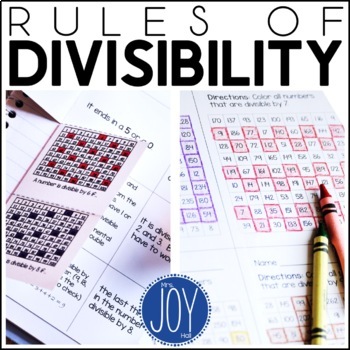Divisibility Rules Notes | Worksheets | Activities and Task Cards DIFFERENTIATED
- PDF
What educators are saying
Also included in
- Easy-to-implement differentiated math kits are quick and effective for teaching rules of divisibility, least common multiples, long division, coordinate graphing, decimals, probability, square roots, multi-digit multiplication, and MORE! Use these fifteen engaging math kits to captivate your studentPrice $93.45Original Price $133.50Save $40.05
Description
Use this print-and-go resource to engage your students in mastering the Rules of Divisibility. From interactive notes to individual and group practice activities, this kit is a powerful solution. You are sure to see results with all of your students!
Included in this purchase:
- Differentiated, Interactive Notes
- Mystery Pictures
- Differentiated, Practice Pages
- Task Cards
DIFFERENTIATED INTERACTIVE NOTES
Interactive notes are an amazing way to engage students in a multisensory way. The first version is blank for the students to complete. The second version is completely filled in. I have also included a page where students could cut and glue the inside notes. This gives you options to fit your classroom needs.
MYSTERY PICTURES
I have found that students need concentrated practice using the rules in order to fully understand how they work. The following pages have a grid of numbers for students to practice on for each rule. There are two different ways you can use these pages. The first two pages have all nine pictures together. That can be overwhelming for some students, so the pages that follow have one rule one each page. They are meant to be cut apart, so each student has a quarter of a page.
DIFFERENTIATED PRACTICE PAGES
Included in this file are two different practice pages. Each page has a modified version, for students who need a little extra help. Students are given a number and will check which divisors it is divisible by.
TASK CARDS
There are 32 task cards with questions on varying complexity. The question types include open response, multiple choice, multiple select, and multi-step. Students need to have a firm understanding of the rules of divisibility in order to solve these problems. There are multiple ways to use these cards. You can simply copy and pass them out as packets. You can also copy and cut into sets and have small groups work together on them. I even like to post them around the room and have students move around to answer them.
*********************************************************
OTHER RESOURCES
Differentiated Least Common Multiples Pack
Mighty Multiplication eBook – 2 x 1, 2 x 2, etc.
Perfect Squares and Square Roots Exploration Kit
*********************************************************






